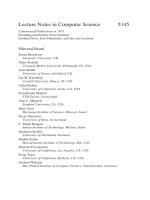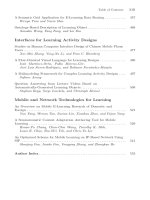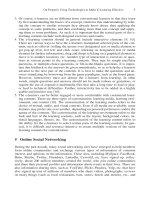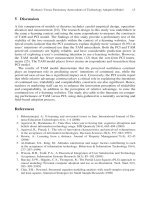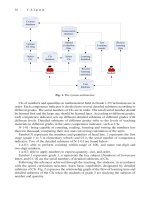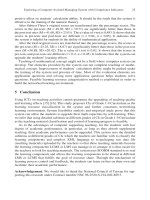Lecture Notes in Computer Science- P65 ppt
Bạn đang xem bản rút gọn của tài liệu. Xem và tải ngay bản đầy đủ của tài liệu tại đây (84.52 KB, 5 trang )
Construction of Project-Based Virtual Learning Community 309
the data of the four divisions are stored in the same database, which are distinguished
from each other by the field of Type. When learners browse a webpage, the system
will show one of them by judging the field of Type.
5.2.2 Techniques in the Module of Reflection
To meet learner’s individual demands and make the reflection forms individualized
and safe, not only do the reflection forms mainly employ the technology of eWebedi-
tor, but also the fields of Length and Password is added to them (In which, Length is
used for characters showed. If Length is 0, the form of reflection will be completely
showed.). When learners input the password of the reflection form and submit, the
system will execute encrypting in the use of md5 (which is only used to encrypt, not
to decrypt.) For example,Strings will be encrypted as followed:
Dim strPlainText as String=”Encrypt me!”
Strings will be stored in the array as followed:
Dim hashedDataBytes as Byte()
Dim encoder as New UTF8Encoding()
To construct MD5CryptoService as followed:
Dim md5Hasher as New MD5CryptoServiceProvider()
To execute encrypting as followed:
hashedDataBytes =
md5Hasher.ComputerHash(encoder.GetBytes(strPlainText))
Judging from the examples as above, before encrypting a string, we must convert
the string into an array at first, which will use GetBytes from Class UTF8Encoding to
convert a string into an array and output the encrypted results from the array.
5.3 How to Sum Up Learner’s Achievements
Assessments on PBL process, a group’s works, online tests are implemented by learn-
ers themselves, partners and teachers. In general, assessments are divided into test
evaluation, PBL process evaluation and performance evaluation. Learners use rubrics
to make quantitative assessment over themselves and others. Teachers also use the
same rubrics to make quantitative assessment over learners.
5.3.1 Assessment over the Process of PBL
In learning, partners of a group know about each other better, which makes as-
sessment objective. At first, whether the student is evaluated by others and him-
self/herself, if not, the system will show the hyperlink of assessment (whose codes
are “evalstudent.asp
userid=stuID”) and come out the webpage of PBL process
rubrics with the five grades of best, better, good, pass, bad showed by 5,4,3,2 and
1. Finally, the form is submitted and the program of evalstudentok.asp will execute
grading.
310 X. Zheng and F. Wang
<% … …
…………To connect a database and construct a muster…………
if not rs2.eof then’ whether he/she is evaluated
……’(IF he/she is evaluated, the system will show
her/his marks.)
Else
sql="select * from evalsubitem"
set rs=server.CreateObject("Adodb.recordset")
rs.open sql,conn,1,3
usercent=0'(marks provided by users)
while not rs.eof
str=request.Form("eval"&rs("EvalSubId"))’(gett
ing data from users)
usercent=usercent+cint(str)’(step is 5)
rs.movenext:wend
Subcent=Subcent+usercent
rs1.movenext
allcent=subcent
set rs3=server.CreateObject("Adodb.recordset")
sql3="select * from evalresult where user-
name='"&username&"' and fromuser-
name='"&session("username")&"'"
rs3.open sql3,conn
if rs.eof then'(to insert results)
if username=session("username") then
zd=EvalSelf’ (marks from evaluation is written
to the field of EvalSelf)
else
zd=EvalGroup’marks from partners in a group is written
to the field of EvalSelf
end if
sqlstr="insert into evalresult (Produc-
tid,username,fromusername, "&zd&" ) values ("&session
("productid")&",'"& username & "','" & ses-
sion("username") & "'," & allcent &")"
conn.execute(sqlstr)’(marks is written to the database and the system gives data of
success and results.)
end if
end if end if
%>
Construction of Project-Based Virtual Learning Community 311
The same technique is used to realize the function of assessment over PBL process
given by teachers, which is somewhat different in rubric from by partners. Marks, which
is from evaluation given by teachers, is written to the field of EvalTeacher. Meanwhile,
during the course of assessment, the system will record who is evaluating or evaluated in
order to judge who has evaluated or been evaluated. With regards to different criteria in
evaluating works, the system is been programmed as the following.
<%
…………to judge whether the teacher has evaluated the stu-
dent………………
‘The following is to sum up achievements in works.
Works achievements are equal to powers of criteria mul-
tiply marks and divide 5 which stands for five grades.’
set rs1=conn.execute("select * from EvalEdusub ")
if not rs1.eof then
while not rs1.eof
usercent=request.Form("evaledu"&rs1("id"))
percent=rs1("percent")
thisnum=usercent*(percent/5)
edunum=edunum+thisnum
rs1.movenext
wend
%>
5.4 The Module of Achievement Inquiry
Only if teachers have announced when achievements can be inquired can students
inquire about their own achievements made up of theory test and PBL achievements.
Their powers vary with different programs and subjects, so the modules for teachers
set up powers of some assessment components (i.e. See Table 1).
Table 1. Powers of Assessment Components
Power of theory test
achievement
30%
PBL Proc-
ess(60%)
·Self-assessment(5%)
·Assessment from partners in a group
(35%)
·assessment from teachers(60%)
Powers of PBL(70%)
Works(40%)
·assessment from teachers(60%)
·assessment from other groups(40%)
312 X. Zheng and F. Wang
Achievements summed up by the formulas as followed:
PBL achievement = achievement of PBL process *its power + works
achievement* its power
(1)
achievement of PBL process = self-assessment*its power + partner’s assess-
ment * its power + teacher’s assessment * its power
(2)
works achievement = teacher’s assessment * its power + group’s assessment *
its power.
(3)
final achievement = theory achievement * its power + PBL achievement * its
power.
(4)
Their codes as followed:
<%
……………………To acquire a power variable ………………………………
PBLcent=CDbl(evalself*pblself)/100+CDbl(evalother*pblot
her)/100+CDbl(evalth*pblth)/100 {evalth means evalua-
tion from a teacher}
Wkcent=cdbl(wkst*wkst)/100+cdbl(wkth*wkth)/100
cent=cdbl(pbl*(cdbl(pblcent*xx)/100+cdbl(wkcen
t*wk)/100)/100)+cdbl(llMark*ll)/100
…………………………………………………………………………
%
6 Conclusion
The system of PBVLC has been exploited by the curriculum TV Program Production
since 2005. Now the system has been used by 200 students. They used the system to
complete online cooperation, brainstorming, interaction with teachers. The authors
made a survey to 200 students. In that, 88 percent students think the system is better
because of multi-meta assessment and brainstorm. However, 12 percent students
cannot accommodate such a learning style because they think the assessment is too
complicate, and the assessment has not been justice. In other words, the system is
required to modify the rubrics of the assessment and confirm scientific rubrics.
As the system is developed appealing for modern educational concepts, now it’s
adopted by the curriculum Research Methods of Educational Technology and the cur-
riculum Modern Educational Technology, which is a provincial fine course. The two
curricula use it as cooperation and webquest. Besides
it has been adopted by Com-
puter-based Education Society, whose website is http://www. accbe.com/pbl.
Construction of Project-Based Virtual Learning Community 313
References
1. Thomas, J.W.: A review of research on Project-based Learning. R/OL (2000),
2. Li, J.: Reforms and Practices of IT curriculum. R/OL,
3. He, K., Zheng, Y., Xie, Y.: Instructional System Design (ISD), p. 183 M. the Publishing
House of Beijing Normal University
4. Zhang, R.: Exploring learning in America. J. Journal of Education Development Research 8
5. Miao, F.: Ideas and implementation of Assessment in IT Education. M. the Publishing
House of Higher Education
